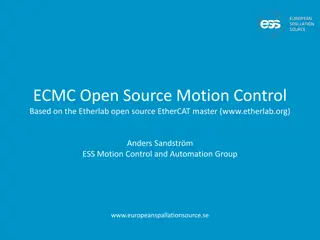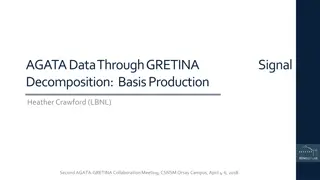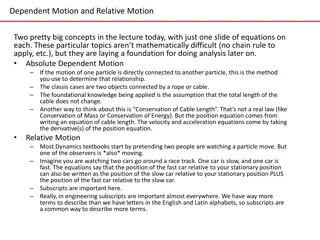Understanding the Biological Basis of Human Motion and Motor Learning
In the biological basis of human motion, a series of electro-chemical-physical reactions occur at the neuromuscular junction, enabling nerve stimulation for muscle contraction. Nerve impulses for movement originate in the central nervous system or muscles, with acetylcholine transmitting impulses between nerves and muscles. Additionally, kinesthetic sense impulses from muscles contribute to movement awareness and coordination, improving with repeated efforts. Receptor organs like the Golgi tendon organ play essential roles in body movement.
Download Presentation

Please find below an Image/Link to download the presentation.
The content on the website is provided AS IS for your information and personal use only. It may not be sold, licensed, or shared on other websites without obtaining consent from the author. Download presentation by click this link. If you encounter any issues during the download, it is possible that the publisher has removed the file from their server.
E N D
Presentation Transcript
Motor learning and human performance. HKE 411 PROF TOLA ODUYALE
BIOLOGICAL BASIS OF HUMAN MOTION A combination or series of electro-chemical-physical reaction occurs at the neuromuscular (muscle-nerve) junction, this enables a nerve to stimulate the muscle to (shorten) contract. A shortening of all the cells in the muscle fiber usually occurs as a generalized response of the cells when a nerve stimulates the muscle. This overall shortening results in the pulling on the tendons connecting the entire muscle to bones at each end.
contd Nerve impulses which initiate movement originate in the central nervous system or in the muscles themselves. For a voluntary muscular movement, the impulse originates in the motor area of the cerebral cortex of the brain. It travels down the spinal cord, out through the motor nerve to the junction of the muscle and nerve, called the motor End plate.
contd When the nerve impulse arrives at the motor end plate, it stimulates the production of a chemical, acetylcholine. Acetylcholine is the substance that transmits electrical impulses across the short gap between the nerve ending and the muscle. The impulse is then received by the muscle membrane and conducted through the membrane to the contractile substance within the cells of the muscle; the muscle fiber is consequently shortened.
contd In addition to impulses which emanates from the brain, there are impulses that originate within the muscles themselves, these are kinesthetic sense impulses. These impulses allow an individual to have a feeling of a position and movement. For example in stroking tennis-balls, a player can tell without looking, the position of his hands and feet. The muscle spindle is an organ that lies parallel within the muscle itself. At normal muscle length, the spindle discharges nerve impulses of a certain frequency.
contd When the muscle is extended, there is a simultaneous increase in the frequency of discharge which is proportional to the amount of muscular extension (stretch). It was confirmed by Cheffers and Evaul that skill (quality of work) improves with repeated efforts because of the increased nerve-muscle-bone synchronization process usually referred to as coordination.
THE RECEPTOR ORGANS IN THE BODY AND MOVEMENT The Golgi tendon organ is a kinesthetic sense organ that is used by the brain to determine the position of fibers and the tendon at either end of the muscle in line with the muscle fibers. The golgi tendon organs are stretched both when the muscle is shortened and when it is lengthened, causing them to discharge nervous impulses. According to Cheffers and Evaul (1978), the frequency with which these impulses are sent to the brain is interpreted as a feeling of position .
contd Another receptor is found within the joints themselves, this is sensitive to the position and rate of movement of the joint. The brain invariably is able to determine the relative position of body parts through interpretation of the frequency of impulses sent by the muscle spindles, the golgitendonorgans,andthejointreceptorsofthemusclesinvolved. The Pacinian corpuscle is another kinesthetic sense organ. This organ transmits impulses when it is compressed or deformed. They are particularly prevalent in the sole of the feet. Increased pressure on the Pacinian corpuscle helps a person "feel" when he is leaning toward onesideortheother.
contd Participationinsportsinvolvestheuseofthekinestheticsenseorgans,sothatthe right movement is made automatically without giving it much thought. According to Cheffers and Evaul, a reflex movement is exhibited by the skilled performer who has conditioned the movement pattern so that his muscles will respond correctly to a specific stimulus. In addition to the kinesthetic sense organs mentioned above, the brainusesthemorecommonlyknownsenseofsight,touchandbalance(innerear)to interpretthepositionandmovementsofthebody.
MOTOR SKILLS What is a skill? Answer: Answer: The knowledge of any art together with expert ability to put that knowledge to use. Skill is said to be a relative quality, e.g. the degree of proficiency attained by the individual in physical education activities reflects his skill level.
Motor Skill Motor Skill contd contd Higher degree of skills coincide with high degree of spatial precision and timing, timing is very important in skilled performance, it appears that in order that skill is to be presented in motor activities, at least four variables must be considered: (i)Most skills should be performed within a time limitation hence the importance of speed, (ii)Accuracy determines how successful these acts are to be executed.
contd contd (i)Form, which refers to the economy of effort demands that skilled activities should be performed (executed) with minimum amount of energy expenditure. (ii)Finally, a skilled individual should be adaptable, such that he can perform under varied or even unpredictable conditions. Perhaps skill should be interpreted as the degree of success in achieving an objective with efficiency and effectiveness. Motor Skills and desired bodily motions required for successful execution of a desired act, motor skills can either be Fine or Gross:-
contd Fine Fine Motor Motor Skills Skills This involves neuro-muscular co-ordinations. Activities involved in fine motor skills are usually precision oriented and often referred to as Eye-Hand coordinated skills, e.g. Archery, Dart throwing, Pistol shooting, etc. They are fine muscle activities. Gross Gross Motor Motor Skills Skills These are large and entirely whole, they are neuro- muscular co- ordinations which involve vigorous contractions of large muscles and usually movement of the whole body, e.g. Sprinting, Jumping, Cycling, Swimming, Dancing, etc.























